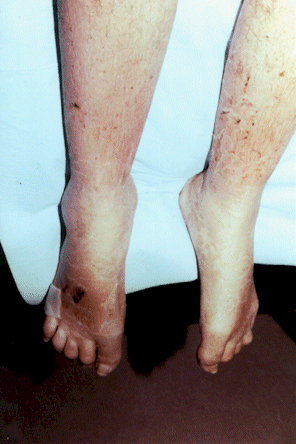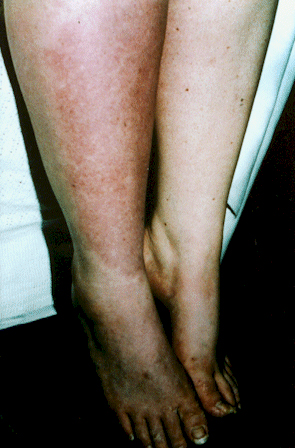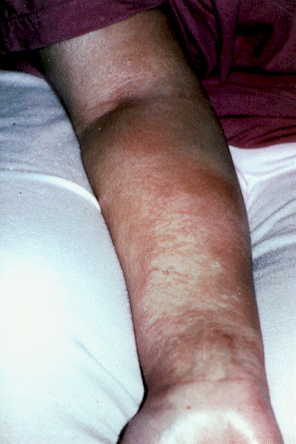History and exam
Key diagnostic factors
common
history of trauma
The vast majority of patients develop CRPS as a consequence of trauma including soft-tissue injuries, sprains, surgeries, and fractures. The trauma may be only minor.
history of immobilization
Such as casting following fractures.
Scaphoid cast immobilization for 4 weeks in healthy volunteers (i.e., in the absence of initial trauma) has been associated with limb signs and symptoms seen in CRPS.[32]
female sex
chronic pain
The cardinal symptom of CRPS. Often described as burning, sharp, lancinating, shooting, electrical, and radiating, becoming dull, boring, and aching with chronicity. Pain severity is out of proportion to the inciting event and pain continues, with spontaneous exacerbations, after healing.
limb pain with radiation
CRPS affects the extremities; the upper limb is more frequently affected than the lower limb.[4][5] Truncal or facial CRPS is very rare.
Pain is not confined to a specific dermatomal distribution and may spread contiguously, to involve the entire limb. The pain may spread to the other ipsilateral limb (e.g., from left arm to left leg) or to the same limb contralaterally (e.g., left arm to right arm); diagonal contralateral spread (e.g., right arm and left leg involvement) is relatively rare (approximately 17%).[33]
allodynia and hyperalgesia
Excessive sensitivity to non-noxious stimuli (allodynia) and noxious stimuli (hyperalgesia) occurs in association with pain, usually distally, and not in a particular peripheral nerve or dermatomal distribution.
body scheme changes
edema
Due to vasomotor disturbance.
trophic skin and nail changes
Thin skin and brittle nails may occur; nails may grow at different rates.[Figure caption and citation for the preceding image starts]: Atrophic skin and loss of hair; ulcer on right footReprinted with permission from the Reflex Sympathetic Dystrophy Syndrome Association [Citation ends].
erythema or bluish appearance
Due to vasomotor disturbance. Warm erythematous skin is more common early in the clinical course, whereas a cold bluish appearance is more common in late presentation. Worsening in cold damp weather is a frequent complaint. [Figure caption and citation for the preceding image starts]: Brawny edema with reddened and thickened skin, increased nail growth of great toe, and deep ulcerated lesion at top of footReprinted with permission from the Reflex Sympathetic Dystrophy Syndrome Association [Citation ends]. [Figure caption and citation for the preceding image starts]: Skin shedding from arm and upper bodyReprinted with permission from the Reflex Sympathetic Dystrophy Syndrome Association [Citation ends].
[Figure caption and citation for the preceding image starts]: Skin shedding from arm and upper bodyReprinted with permission from the Reflex Sympathetic Dystrophy Syndrome Association [Citation ends].
local sweating changes or sweating asymmetry
Increased sweating may be seen over the affected area due to sudomotor disturbance, or a difference between opposite sides may be noted.
muscle weakness
Weakness, tremors, and dystonic posturing are often seen. Patients may immobilize the extremity, which could lead to contractures, particularly in the upper extremity.
Other diagnostic factors
common
tremors
Motor abnormalities are common in severe disease.
dystonic posturing
Motor abnormalities are common in severe disease. Tendency to keep limb immobilized may lead to contractures.
contractures
May develop due to immobilization and disuse of the affected limb.
uncommon
sensory loss in glove and stocking distribution
Decreased perception of specific stimuli in a nondermatomal glove or stocking distribution in the affected limb. May accompany allodynia/hyperalgesia.
local changes in hair growth
Affected area may exhibit excess or absence of hair. [Figure caption and citation for the preceding image starts]: Atrophic skin and loss of hair; ulcer on right footReprinted with permission from the Reflex Sympathetic Dystrophy Syndrome Association [Citation ends].
skin bullae
Although uncommon, may appear in the affected area.
Risk factors
strong
trauma
The vast majority of patients develop CRPS as a consequence of trauma including soft-tissue injuries, sprains, surgeries, and fractures. The trauma may be only minor.
Mild type 1 CRPS may follow 30% to 40% of fractures and surgical trauma; severe and chronic type 1 CRPS occurs with up to 4% of fractures.[7][8][9] There is a relationship between the severity of the injury and the risk of developing persistent pain.
Type 2 CRPS occurs with approximately 4% of peripheral nerve injuries.[10]
immobilization
Such as casting following fractures.
Scaphoid cast immobilization for 4 weeks in healthy volunteers (i.e., in the absence of initial trauma) has been associated with limb signs and symptoms seen in CRPS.[32]
Use of this content is subject to our disclaimer